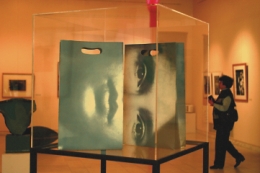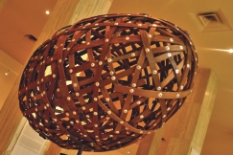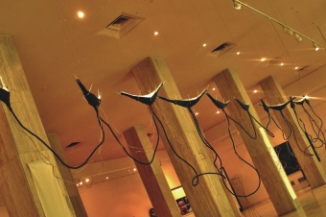Myth in the day
 Ancient rites and a search for a modern identity coalesce perfectly in a new exhibition of Chilean art Ancient rites and a search for a modern identity coalesce perfectly in a new exhibition of Chilean art
One of the most moving artworks are children's drawings. They are often a pure and direct expression of a child's candid violence. Such clarity and honesty is present at the National Museum of Art in its temporary exhibition ‘Chilean art crossing borders’.
This touring exhibition unites the works of Chile's contemporary and modern artists, showing signs of a vibrant artistic life from between the Pacific Ocean and the Cordillera Andes.
The eleven sections of Chilean art offer 78 works of painting, sculpture, photography, found objects and mixed media, grouped according to themes. Some of the transcontinental pilgrims depict the landscape of their home, like Josefina Guilisasti's Combina-tions, a diary-like series of views on the same melancholic homeland.
 Other Chileans speak of their rich and deep identities, whispered like a childish chant in a mestizo language of naivete and seriousness, such as The saint, a black and white photograph by Mariana Mathews, illustrating the mergence of native and Christian rites on Chilean land. Other Chileans speak of their rich and deep identities, whispered like a childish chant in a mestizo language of naivete and seriousness, such as The saint, a black and white photograph by Mariana Mathews, illustrating the mergence of native and Christian rites on Chilean land.
'Precolumbine' art is the family name of many of the artists in the exhibition. Zinnia Ramirez chants For life and abundance, a work of ceramics and natural elements and a good luck charm of her ancestors. A knotted-fibre sculpture, The Chiu-Chiu princess by Ester Chacon and Osvaldo Pena's Tree of life, carved in cypress wood, are the feminine and the masculine symbolic embodiments of fertility, seasoned with a pinch of humour.
When ancient myths are expressed through contemporary art, a memory of the self is retrieved. Isabel Margarita Perez says Gracias a la vida, using a pre-columbine technique of knotting, the Quipu, an Inca artifact used for counting. Mauricio Guajardo replies with Lemu Kura (stone woods in the indigenous Mapudungun language), the name of his carved granite and forged steel vision of the petrified forests of Chile.
 Storytelling through art is also a major theme. In Francisco Copello's With Chile in my heart, he shows a canvas-size heart, big enough for a distant and vivid series of tales about his homeland. Storytelling through art is also a major theme. In Francisco Copello's With Chile in my heart, he shows a canvas-size heart, big enough for a distant and vivid series of tales about his homeland.
When Chilean art crosses borders, it charms, speaks out and lives out today's fears and yesterday's rumours of indigenous myths in an honest, direct and moving manner.
‘Chilean art crossing borders’ is at the National Art Museum, Calea Victoriei until May 15.
Open Wednesdays to Sundays, 11:00 to 19:00 hrs.
|